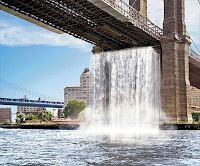
Olafur Eliasson's New York City Waterfalls. Four man-made waterfalls, ranging in a height from 90—120 ft., in New York Harbor.
 On a postcard, a bridge is not a bridge, it is an image of a bridge, a useless prop of two-dimensionality, devoid of all its functionality. I took this idea of props and focalized my piece around objects that could be used as stand-ins, or illustrations for the originals in their most simplest form. I sought out objects that could merely serve my purpose. Fruit crates, delivered and emptied, turned upside down stands in for the many bridges of this small town. Bricks taken from the crumbling city walls, reminders of a decaying city, a reality directly contrasting to the image of the picturesque. In the end, I sought to challenge the idea, as I feel the images in post cards and advertisements do unconsciously, of what a landscape is. What a bridge is. What a bridge is when it loses its purpose, and becomes nothing but an image, or rather more, an abstract, sculptural representation of that image.
On a postcard, a bridge is not a bridge, it is an image of a bridge, a useless prop of two-dimensionality, devoid of all its functionality. I took this idea of props and focalized my piece around objects that could be used as stand-ins, or illustrations for the originals in their most simplest form. I sought out objects that could merely serve my purpose. Fruit crates, delivered and emptied, turned upside down stands in for the many bridges of this small town. Bricks taken from the crumbling city walls, reminders of a decaying city, a reality directly contrasting to the image of the picturesque. In the end, I sought to challenge the idea, as I feel the images in post cards and advertisements do unconsciously, of what a landscape is. What a bridge is. What a bridge is when it loses its purpose, and becomes nothing but an image, or rather more, an abstract, sculptural representation of that image.

